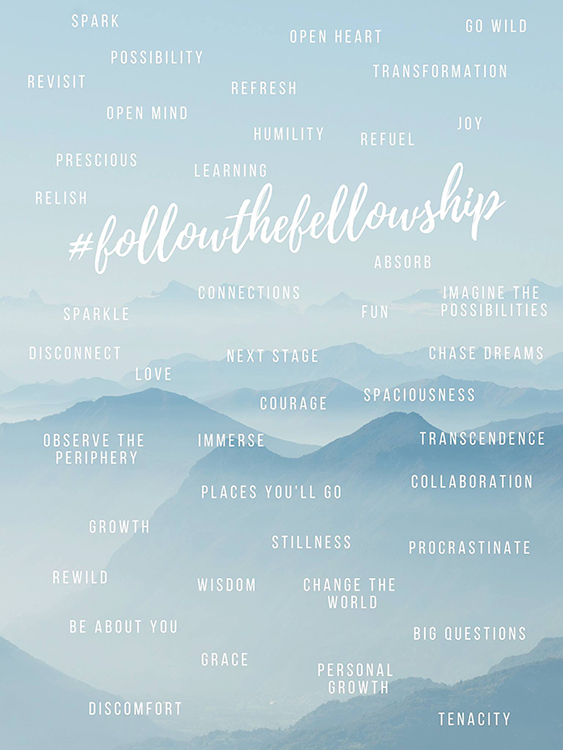#followthefellowship blog entry by Michelle Baldwin
Wishful Thinking
It was two years ago when, in an executive leadership coaching session, the idea of a sabbatical or fellowship came up. It was with a laugh and the comment, “That does not happen in nonprofits,” then I brushed it off. Janet Frood, from Horizon Leadership, asked “Why not?” and sent me links to opportunities that exist in the U.S.
 Fast-forward to Tonya Surman, CEO of Centre for Social Innovation, embarking on a 3-month sabbatical that ended up being extended to 6 months. Tonya promised, as part of this opportunity, to support 2-3 other leaders to share this transformational experience:
Fast-forward to Tonya Surman, CEO of Centre for Social Innovation, embarking on a 3-month sabbatical that ended up being extended to 6 months. Tonya promised, as part of this opportunity, to support 2-3 other leaders to share this transformational experience:
“Taking time, creating space for others to lead in my absence, was an incredibly powerful process to support the growth of CSI. After 6 months, I was transformed, I was finding my source, my power, my energy coming from such a good place, such a place of connection, to our mission and a new commitment to making the world a better place."
As I considered what was next, I knew that documenting the origin stories of Pillar, Innovation Works and VERGE Capital was part of the next stage of work that I wanted to commit to. I started to look at formal fellowship opportunities but the timing did not line up, so I created my own Reflective Practice Fellowship. I asked myself, “What do I hope to get out of this experience and what are the questions that I want to dig deeper on?”
When I presented to the board in December 2018, Tonya Surman joined us to share her experience. The proposal was met with enthusiastic approval and I shared the news with the staff team with exuberant excitement. Our Board Chair, Jason Kerr shares:
“In academic circles, the concept of a professional leave or sabbatical is commonplace. In nonprofit and other workplaces it is almost a foreign concept. The opportunity for a senior leader in an organization to both reflect on their own PD, but also to research topics related to their organization’s strategic directions or plan is priceless. In Michelle's case, you have a leader that has been operating at a high level for the better part of a decade. To be able to have this time allows a leader a chance to renew themselves and infuse new knowledge and concepts into the organization on their return while allowing others in the organization a leadership opportunity in the leader's absence.
Further Validation through Augmentation
While staff response was positive, I quickly discovered that they were deeply curious about the concept. I sent the fellowship proposal to staff so they could see the good thinking and planning involved.
Over the holidays, as I shared the news with staff and family, I felt incredible support but picked up on some subtext that maybe I was taking six months off. Whether this was real, or my own internal dialogue, I cannot be sure but I responded by promptly adding the word “research” to the title, updating it to “Reflective Practice & Research Fellowship” and sought out a research partner to provide mentorship and lend legitimacy to the project.
Preparing the Team
A full transition plan was developed over the holidays and at one point the ED and Directors talked about sharing parts of it with staff. One Director shared an article that was a turning point for me; “The Secret to Leading Organizational Change is Empathy” highlighted that teams adapt better to change with more information and this inspired me to share more and share often. The transition plan was sent to staff and almost immediately I noticed a shift. One staff member said, “You have really thought this out,” and the sense of uneasiness and discomfort decreased.
We created a culture around the fellowship of asking questions; one question that kept surfacing was how the Interim ED was going to continue to fulfill her existing role and take on added responsibilities. Would this put pressure on staff, who are already at capacity? Finding the proper project management supports for an upcoming elevator upgrade and for building management were essential to create space for the added role. We also created a shared document where people could ask questions and the ED and Interim ED could answer them. We only received one question (about a staffing update), but the “in-person” questions followed, and were more personal in nature.
At a team meeting, Lore Wainwright, Interim ED, shared why she was open to taking on this role: “I'm thrilled to be leading an exceptional team like the one at Pillar. The next six months will be a critical piece of work in leadership, transformation and community impact. This is a servant leadership moment, as I want to make this possible for Michelle and the organization. It’s sort of a ‘pinch me’ moment for me.”
Early Lessons
Here’s what I know at this first lap of the journey:
To navigate a leadership transition takes a village. The board and staff were all essential in creating the conditions for a leadership transition that acknowledged the instability that change can bring, and they leaned into our values of openness, transparency, communication, embracing failure, and learning and co-creation.
Naturally we got some of this right and there were things we could do better. If you’re interested in an overview of the process and practices we followed to prepare our staff team, Board of Directors and network for this interlude, you can find that here.
As we navigate these six months we will be sharing the learning and experience about network building and cross-sector collaboration as well as our high dream for other nonprofit and social impact leaders to have the opportunity for a fellowship experience.
Follow along #followthefellowship:
